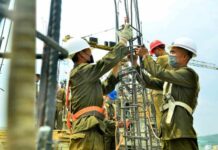[imText1]Kim Young Hwan, who lead the South Korean students’ democratic movement in the 1980s, recently discussed his ideological conversion. He is currently a member of the editorial committee of the quarterly magazine Zeitgeist, and an editorial writer for the Daily NK.
Mr. Kim spread the Juche Ideology and “National Liberation line (so called NL movement in South Korea)” among students through a book written under his pen name, “Kangcheol,” meaning steel or a strong spirit like steel. His book, “Kangcheol’s Letter,” was a manual for the Juche Ideology and played a major part in the students’ socialist movement in the1980s and continues to influence present day South Korean leftists.
However, after a submarine secretly deposited Mr. Kim into North Korea, he met Kim Il Sung, and was converted into an activist for North Korean democratization.
In a conference held by National Development Institute on the 26th, Kim Young Hwan released the story of his ideological conversion and the end of his career as the democratic movement’s “godfather of a Juche faction consisting of 100 thousand students.” He was almost deified by students and activists involved in social movements in the 1980s.
He said that “National Liberation Movement Theory (NL) spread among university students so fast that even he was amazed. NL theory spread among students of Seoul University in just 2 or 3 months and to students of all South Korean universities in 8~10 months.”
“At the time, around 400 police officers had been deployed to catch me. Some of them went so far as to watch my grandmother’s tomb.” After his capture, he experienced “torture for 47 days while under interrogation by the National Intelligence Service. The most pleasant day in this miserable experience was January 9th, 1986 when I was finally imprisoned and delivered from NIS torture.”
“Intelligence bureaus have legitimate interests in prohibiting extra-governmental relationship building with North Korea. However the torture imposed by the NIS served only to strengthen my determination to implement social revolution.” He refused to allow the harsh experience to depress him. What did depress him, however, was the “reality of North Korea.”
After his release, he lead the Democracy Revolutionary Party, an underground organization devoting itself to socialist revolution and in 1991, entered North Korea secretly. He described his visit to Pyongyang: “As I witnessed the declining economic situation in North Korea, I realized there was something else amiss.”
“In a discussion with North Korean scholars on Juche Ideology, I repeatedly asked them what they would do if the supreme leader made the same mistakes as those of the Chinese Cultural Revolution. They could not form relevant responses.” He surmised that North Korea had become the only place where there was no real freedom to study its own Ideology. “I met Kim Il Sung twice, and he knew virtually nothing about Juche Ideology. I wondered if he had read any of the books published under his own name.”
He visited North Korea to establish relationships with North Korean authority, but it provided him a good opportunity to assess the reality of North Korea—specifically that the North Korean regime was a mafia oriented cult. That realization prompted his conversion into a life-long activist for North Korean democratization. In a statement released to the leftist magazine Mal, he said, “The Theory of the Supreme Leader is a deception.”
He said that while few are practically pursuing pro-North Korea and conventional socialism, present day South Korean society is still deeply influenced by the socialistic nationalism of the 1980’s. Regarding the social atmosphere of South Korea, he said that “Overcoming socialistic nationalism is massively important, and I will do everything in my power to reverse this ideological trend in South Korea.” He acknowledges his responsibility for the residual social side effects of past student NL movements.

















